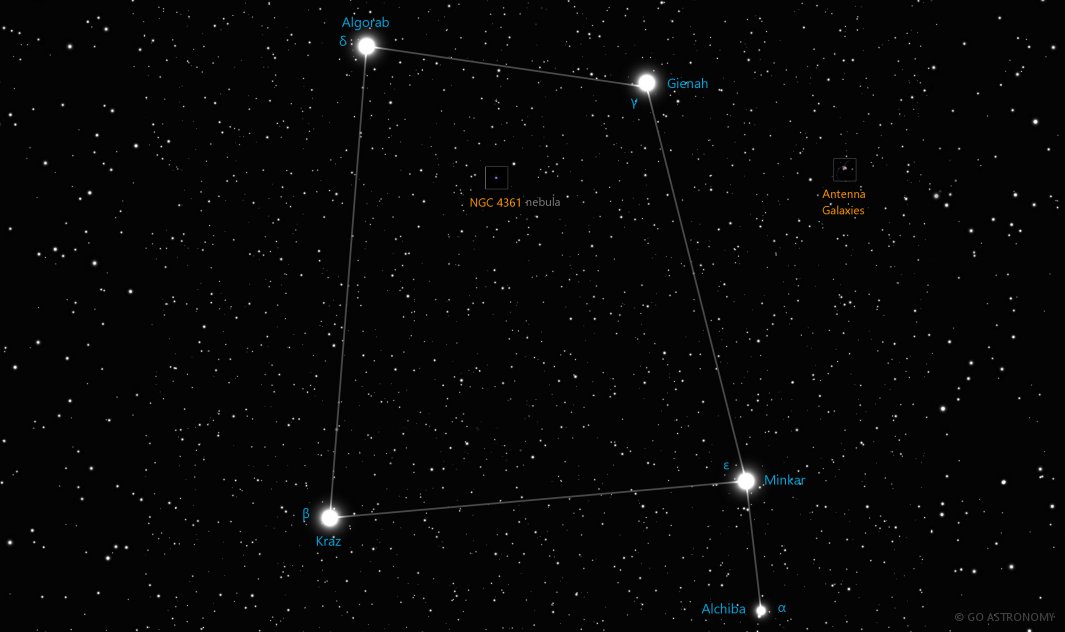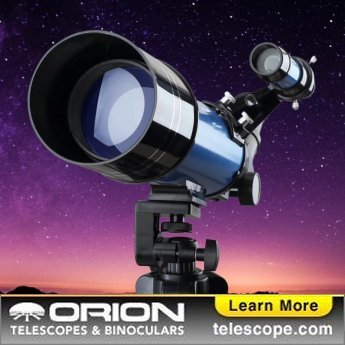Corvus, the Crow (Crv)
(CORE-vus)
The Southern constellation of Corvus, the Crow, is best viewed in Spring during the month of May.
Corvus is the 70th largest constellation. It's brightest star is Gienah at magnitude 2.59. The boundary of the Corvus constellation contains 4 stars that host known exoplanets.
- Pronunciation:
- CORE-vus
- Meaning:
- Crow
- Genitive:
- Corvi
- Abbreviation:
- Crv
- Constellation Family:
- Hercules
- Hemisphere:
- Southern
- Quadrant:
- SQ3
- Visibility:
- 60° N - 90° S
- Best viewing month*:
- May
- Area:
- 184 sq. degrees
- Size:
- 70th largest
- Right Ascension (avg):
- 12h 23m
- Declination (avg):
- -19°
- Brightest star:
- Gienah (2.59)
- Stars with planets:
- 4
- Messier objects:
- |
Brightest Stars in Corvus
The 10 brightest stars in the constellation Corvus by magnitude.
- Star
- Magnitude
- Spectral class
- Gamma Corvi (γ Crv)
- 2.58
- B8III
- Beta Corvi (β Crv)
- 2.65
- G5II
- Delta Corvi (δ Crv)
- 2.94
- B9.5V
- Epsilon Corvi (ε Crv)
- 3.02
- K2III
- Alpha Corvi (α Crv)
- 4.02
- F0IV/V
- Eta Corvi (η Crv)
- 4.3
- F2V
- HD 107418
- 5.15
- K0III
- VV Corvi (VV Crv)
- 5.17
- F3IV
- Zeta Corvi (ζ Crv)
- 5.2
- B8V
- 31 Corvi (31 Crv)
- 5.28
- B2IV
Double Stars in Corvus
These are the brightest and easiest-to-find double, triple, and quadruple star systems in the constellation Corvus. Also see all star clusters.
- Star system
- Magnitudes
- Type
- Delta Corvi
- 2.9, 8.5
- double
Galaxies in Corvus
The most notable galaxies in the constellation Corvus. Also see all galaxies.
The Crow of the Cosmos
Corvus, known as "The Crow" in Latin, is a small constellation nestled in the Southern Hemisphere. Despite its size, it has a notable presence in the sky and in many ancient cultures due to its distinctive quadrilateral shape and the intriguing legends that accompany it.
Historical Overview
The constellation of Corvus has rich historical and mythological significance. In Greek mythology, it is associated with Apollo, the god of prophecy, music, and healing, who sent Corvus, then a white bird, to fetch water. Corvus became distracted by a fig tree and upon his return lied to Apollo. As a result, Apollo turned the bird's feathers black, and Corvus was placed in the sky as a constellation, forever to be thirsty in the desert without water.
Location and Notable Features
Corvus is located in the third quadrant of the Southern Hemisphere and is visible at latitudes between +60? and -90?. It is bordered by the constellations of Crater (The Cup), Hydra (The Water Snake), and Virgo (The Maiden).
Despite being the 70th in size amongst the 88 recognized constellations, Corvus stands out because of its quadrilateral shape, forming a pattern known as "The Spica's Spanker" or "The Sail". This pattern is made up of four primary stars: Gamma, Delta, Epsilon, and Beta Corvi, which have apparent magnitudes ranging from 2.59 to 3.10, making them easily visible to the naked eye under ideal conditions.
Deep Sky Objects
Corvus houses a number of impressive deep-sky objects. These include the Antennae Galaxies (NGC 4038 and NGC 4039), which are a pair of interacting galaxies in the process of colliding and merging. The violent interaction has triggered intense star formation, making these galaxies a point of interest for astronomers studying galactic evolution.
The constellation also hosts NGC 4027, a peculiar barred spiral galaxy known for its single spiral arm, possibly a result of interaction with another galaxy.
Observing Corvus
Corvus is best viewed during the month of May, though it can be seen from February through July. From the Northern Hemisphere, observers can look for Corvus in the southern sky during springtime.
Its small size and quadrilateral shape make Corvus relatively easy to spot. It is also helpful to locate the bright star Spica in the constellation Virgo, as Corvus lies westward of this star.
While the stars of Corvus are readily visible to the naked eye, deep-sky objects such as the Antennae Galaxies require the use of a small telescope. With a powerful enough telescope, one can view the galaxies' tidal tails, which resemble the antennae of an insect, giving them their common name.
* Constellation shown for northen hemisphere skies. For the southern hemisphere, constellations appear rotated 180 degrees (upside-down and left-right reversed) from what is shown. Remember that seasons are reversed too - summer in northern latitudes is winter in southern latitudes.
** Circumpolar constellations are visible year-round in the hemisphere listed (and not at all in the opposite hemisphere).





